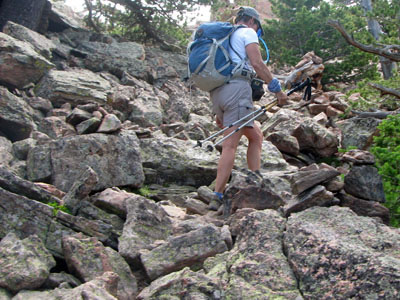| 292 | Hiking Skills - Stride | 2010-10-11 |

On the trail I have observed hikers practicing the same long stride theory. The hiker thinks if they have a long stride they will be able to walk faster. They make long steps. They make high steps over obstacles. If they can make one step instead of two they will gladly take the one. The long stride wastes energy. Depending on how fit the hiker is, they might be fast using the long stride; but they would even be faster and arrive less tired, if they learned how to adjust their stride.
The hiker adjusting his stride for the terrain is like a rider on a multi-speed bicycle. The rider might be able to pedal on a level or downhill section using the highest gear ratio (big ring in the front - small in the rear); but as a hill approachess he shifst down, still pedaling at the same cadence. Some strong riders might even be able to power up a hill using a high gear ratio; but they will not be riding long on those gears if the hill is steep or long.
The exact same theory holds true for hiking. The hiker should shorten his stride; but continue at the same pace or cadence, when the route grows steeper or the terrain is rougher.
A few stride improvement hints...
- Until you are used to adjusting your stride, you will have to make a conscious effort to shift gears.
- Continually scan the trail ten to fifteen feet in front of you. Identify obstacles or changes in the grade and begin to make stride corrections.
- When the trail gets steep, shift into a lower gear; or in other words shorten your stride.
- Step over obstacles at their lowest points. Oh, and step over the obstace, not on top of it.
- Look for ways to shorten tall steps on the trail. Often times you can find a quick sequence of steps to move up the step effortlessly.
- Expand your step arsenal - try side steps and back steps to shorten the obstacle.
- Have fun - it is fun to find ways to simplify a tough section of trail. It is like solving a puzzle.
- Don't forget to lengthen your stride when the path is easier.
- Talk about the sequences with your hiking companions.
- Watch an experienced hiker walk.
- Put in the mileage. The more you practice the better you will become at adjusting your stride.
Mileage, balance, pace, and stride all help you become a better hiker. Changing stride helps you conquer even the steepest terrain with relative ease. Next week we will continue the series with Hiking Skills - Rhythm.
Happy stride along the trails.